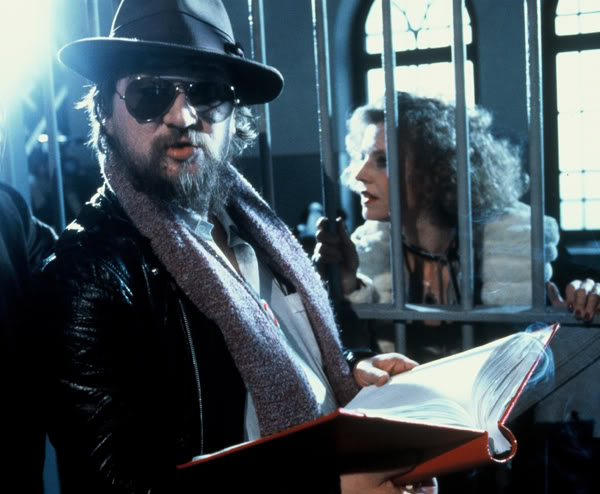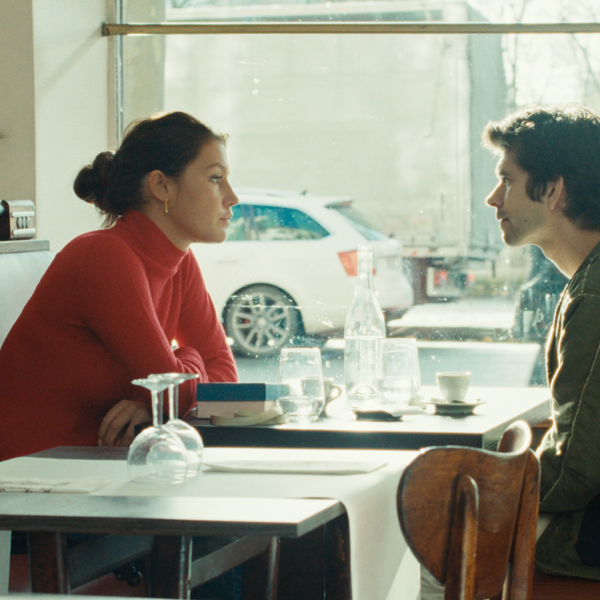“I’d like to be for cinema what Shakespeare was for theatre, Marx for politics and Freud for psychology: someone after whom nothing is as it used to be,” German director Rainer Werner Fassbinder once declared, likely half-seriously, half facetiously.
Fassbinder died in 1982, at the age of 37, from a lethal combination of painkillers and copious quantities of cocaine. Legend has it he was working right up to the moment of his death, and pages and notes from an unfilmed script were found next to his body. In anyone else’s case, this might be mythmaking, but Fassbinder’s back catalogue does prove he was a man constantly, constantly at work: in the course of his short lifetime, as if hemorrhaging emotions and ideas, the uber-prolific filmmaker made an astounding 40 feature films, two television series, three shorts and 24 stage plays. Which begs the question, what have we done with our day? However this frenetic pace exacted a heavy toll; his drug-fueled work ethic was beneficial neither to him nor to those he worked with and many of his relationships (most notably with actress Irm Hermann) were complex (Fassbinder’s bisexuality a factor here) and borderline abusive. He attracted bitter, personal criticism in the press, but at the same time he was fiercely loyal to his collaborators, often employing the same actors over and over again, at least until he alienated them. He was undoubtedly a difficult man, so incandescent with creative and chemical energy that in retrospect it seems inevitable that, burning so brightly, he would burn out early.
But in the midst of his tumultuous personal and professional lives, he became a great director, in his best moments attaining a level of craftsmanship and deeply felt emotion that rather belies his gonzo, wildchild reputation. His finest films show a filmmaker somehow both compassionate and almost aggressively unsentimental in his unromanticized portraits of suffering, lost souls. A central figure in that generation of German cinema that also produced Werner Herzog and Wim Wenders, of course, anyone who made as many films as Fassbinder did wasn’t going to knock it out of the park every time — he himself equated making movies to building houses and some films were plumbing or messy wiring — but there are several bleak classics in his oeuvre, and it’s rare to find one of his films that isn’t worth watching to some degree.
Something of an obscure lost classic from the director, the made-for-TV two-part sci-fi film “World On A Wire,” is currently being re-released in theaters around the U.S. (read our review here, and check the official site to see when it’s playing near you), and we thought we’d use that as an excuse to cast an eye over Fassbinder’s back catalogue. It’s an intimidating collection — we’re not sure anyone on staff has seen more than 45% of his films — but we’ve got a decent spread between us, and for anyone who has yet to discover this fascinating filmography, we hope you’ll find a good place to start here. Check it out after the jump.
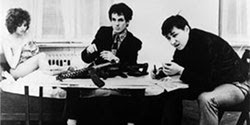 “Love Is Colder Than Death” (1969)
“Love Is Colder Than Death” (1969)
Booed at Berlin but now evidence of the arrival of a truly talented individual, Fassbinder’s debut film offers a personal take on the gangster genre in a French New Wave palette. Thug Bruno (Ulli Lommel, who would become a Fassbinder regular) gets embroiled in a crime syndicate’s plan to kill bad-ass pimp Franz (good ol’ Rainer Werner in the flesh), only for a friendship to spring up between Franz and Bruno. After a successful operation, the team (complete with prostitute Joanna) decide to rob a bank, though trust begins to waver and things don’t go as planned. Like a smash-combination of “Band of Outsiders” and “Le Samurai” with a vague dash of Orson Welles’s “The Trial,” “Love is Colder Than Death” is passionate filmmaking bursting from a head full of creative, boundary-pushing ideas. Confident long takes are constantly employed, the fourth wall is broken without a wince, and occasionally an ethereal, somewhat dissonant soundtrack coats the scenes (even a trip to the grocery store feels heavenly). Some may decry the very apparent low-budget behavior; the biggest culprit being the lack of gunshot wounds (POP, the murdered fall to the ground). However, Fassbinder makes his lack of scratch work: his characters are so unbelievably nihilist that they couldn’t possibly comprehend the weight of their actions. By making the sight of bullet holes and blood seem irrelevant, the director instead focuses on the weight of death — in a stunningly patient sequence, Bruno kills a man and the camera follows him as he struggles to get the body into the car, drives to a dump, and proceeds to bury the body. Topped off with a sense of humor (the trio draw out their theft of sunglasses just to screw with the saleswoman; an arms dealer operates out of a shoe repair shop), “Love is Colder Than Death” isn’t perfect, but it’s the kind of first flick that should inspire energy and optimism in this generation’s young filmmakers… if they haven’t already drowned in student loan debt. [A-]
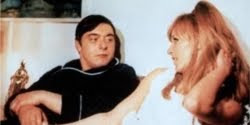 “Why Does Herr R. Run Amok?” (1970)
“Why Does Herr R. Run Amok?” (1970)
Quite possibly the man’s simplest feature (not in terms of substance but in style of storytelling), ‘Herr R.’ attempts to study the circumstances that may (or may not) cause an extremely average person to commit murder. Fassbinder examines the titular character’s life down to the most mundane, minute detail, from helping his son with homework to enduring his peers’ stand-up routine. These scenes become even harder to swallow during a post-screening (or second watch) analysis, as Kurt Raab’s expressiveness yields many complexities — it would’ve been easy to play the character empty or neutral, but the Czech actor lumbers around, taking in each moment in a way that suggests that each irritation, disrespect, and awkward moment is slowly piling up, and may be about to break him. Or maybe they’re not. One can certainly debate the impact of any given scene and argue about whether it, on its own, flicks the switch; but one can always also look at the other side of the coin and argue for innocence. The way the filmmaker lays out the complicated birth of violence without giving any concrete answers gives the proceedings both a psychological respect and an almost inexplicable horror — Fassbinder knows human beings are much too complicated for simplistic and reductive labels. His approach is enticing; indeed, Michael Haneke made his bread-and-butter out of it and a more modern take on this slow-burn observation can be seen in Cristi Puiu’s “Aurora.” It’s admittedly a bit of a patience-tester, but there’s something undeniably engrossing about it. It’s worth noting that the authorship of this one is somewhat controversial: Hanna Schygulla, one of Fassbinder’s favorite actors, claims that co-director Michael Fengler was basically responsible for the film. [B+]
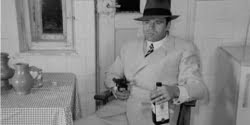 “The American Soldier” (1970)
“The American Soldier” (1970)
His third feature-length effort (‘Why Does Herr R. Run Amok’ was a co-directorial effort), and his second made that year, if you’re accustomed to the Sirk-ian melodramas of Fassbinder’s middle-section career, the French New Wave-ish “The American Soldier,” sticks out like a glaring anomaly; a stylish, noir crime picture that feels like it could have been made by Jean-Luc Godard (but it’s actually the third in his early gangster trilogy.) Almost. Using gangster tropes to express the frustrations of love — and indeed, the eponymous titular hit man played by familiar and softspoken Fassbinder actor Karl Scheydt seems to spend a lot of time in bed naked with women, yet without ever feeling any true ardor — the picture looks like a Raoul Walsh-made gangster picture, but feels more existential in mood and tenor (the closest comparison might be Godard’s “Alphaville,” but it’s not quite as odd). The plot centers on Scheydt, a restless American back from Vietnam hired to play assassin by the State and wipe out Munich’s underworld. He does just that, but then runs into trouble when three policeman hire him to knock out their own adversaries, but plan a double cross. Plot hardly matters though in this picture in which Fassbinder has a small role as a collaborating thug; it’s uniquely Fassbinder: a genre picture employed as a mask for something much more inscrutable. [B]
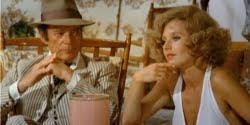 “Beware of a Holy Whore” (1971)
“Beware of a Holy Whore” (1971)
The good ol’ film about filmmaking. Some of our best auteurs have delved into this sub-genre; the likes of Francois Truffaut, Woody Allen, Olivier Assayas, and Federico Fellini have all contributed to showcasing the often ridiculous moments that occur behind the camera. It’s easy to see where these pros saw such ripe material — use the medium to decry its inherent mayhem — but it’s tougher to see why we, as an audience, should ultimately care. Shot when the director was 25 and based off personal experiences had during the production of “Whity,” the incredibly-titled “Beware of a Holy Whore” suffers from the same flaws that most of these movies do (with the likely unanimous exception being “8 1/2”; the other exception will probably be from whatever director you’re particularly hot for). The plot concerns a crew who, led by a wavering film director (Lou Castel, who also makes an appearance in “Irma Vep”) and a ticked-off producer (played by an angry Fassbinder), have trouble pulling together to block a single scene. Money is dropped, tensions rise, egos are bruised — always the ingredients for a solid drama. As a director Fassbinder plays things slowly at first, then as the descent into frustration begins, scenes come and go much more frantically. It’s not without its moments (such as the opening monologue about Goofy becoming a failed kindergarten teacher), but there’s something unavoidably tenuous about the whole thing. Maybe it’s the fact that we know all of these horrors already; or possibly it’s that, Fellini’s opus excluded, they all travel down a similar road to the same conclusion. Too “inside baseball”? Too “wink-winky” to filmmakers? Hard to say, exactly. The filmmaker’s portrayal of himself, judging from reports on his personal life and behavior, seems to be spot-on and it’s definitely worth seeing him at his rawest. Unless you’re a fanatic, though, you might find the rest of the proceedings a tad unilluminating. [C+]
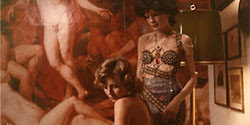 “The Bitter Tears Of Petra Von Kant” (1972)
“The Bitter Tears Of Petra Von Kant” (1972)
The term melodrama has come to have negative connotations: over-played, over-egged emotion, with little subtlety or subtext. But as Darren Aronofsky proved last year with “Black Swan,” if you don’t mind going full throttle with your drama, you can truly achieve something special, and Fassbinder kills it in “The Bitter Tears of Petra Von Kant.” Based on his play of the previous year, which itself, according to Jonathan Rosenbaum, was heavily autobiographical, (a veiled version of the triangular relationship between the director, his black Bavarian lover Günther Kaufmann and his assistant/composer Peer Raben), the film follows the titular fashion designer (Margit Cartensen) as she falls deeply in love with the beautiful Karin (Hanna Schygulla), all the while tormenting her devoted assistant Marlene (Irm Hermann). It’s unashamedly campy (its 2005 translation to opera was inevitable), nodding to Fassbinder’s beloved Douglas Sirk (the helmer even visited the veteran director at his home in Switzerland at one point) and “All About Eve” (that film’s director Joseph Mankiewicz gets a name check at one point), but it’s also eminently quotable, and entirely gripping. Thanks partly to DoP Michael Ballhaus (who would go on to shoot “The Last Temptation of Christ,” “Goodfellas” and “The Departed” for Scorsese, among many other Hollywood projects), it works where so many theatrical adaptations fail: rather than stagy, it feels almost impossibly claustrophobic, as the characters’ bitter, unrequited love affairs trap them in the apartment that the camera never leaves. The acting too, is astonishing, particularly Fassbinder favorites Cartensen, entirely fearless, and Hermann, who steals the show in a virtually silent performance. The sexual politics might be problematic for some, but there’s no doubt that it was close to the director’s heart, and no surprise that it became one of his first films to break out to an international audience. [A-]
 “Ali: Fear Eats the Soul” (1974)
“Ali: Fear Eats the Soul” (1974)
Fassbinder met Douglas Sirk at the Munich Film Museum in 1971, where he also saw six of his films. That experience would change the way Fassbinder saw and made films. Sirk’s “All That Heaven Allows” provided the inspiration for “Ali: Fear Eats the Soul,” which today remains Fassbinder most famous film (not infamous for once), which went on to inspire Todd Haynes’ “Far From Heaven.” No Fassbinder film conveys its message of everyday social evils as eloquently as “Ali: Fear Eats the Soul.” The basic premise is simple: middle aged German widow, Emmi, randomly meets and, quite soon after, marries, Ali, an Arab man she encounters in a bar after taking shelter from the rain. The first half of the film focuses on how Emmi’s family, neighbors and workmates deal with her second husband and the colour of his skin, negatively at first and then shifting towards acceptance. The second deals more with Ali’s reaction to their sudden acceptance, which brings its own set of compromises for him, and conflicts with Emmi once hidden by their mutual solidarity against racism also emerge. Fassbinder, never one for concrete conclusions or easy answers leaves us with a bittersweet ending with lovers reunited but the problems that divided them unsolved. [A]
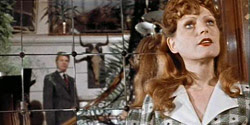 “Martha” (1974)
“Martha” (1974)
Another Sirk-ian drama of domestic unhappiness — the lead character even gives out “Douglas Sirk Road” as her address at one point — like many Fassbinder melodramas, “Martha” places the titular female naif in a situation of emotional distress and then makes us watch, squirming helplessly, as she is put through escalating crises and disabused, practically brutalized, of all romantic notions. A film that could have been sarcastically titled, “The Good Wife,” the melodrama centers on Martha (Margit Carstensen) who goes from one bad situation to another, and can arguably be called a bleak study in both cruelty and the capacity for human submission. While on vacation with her in Italy, Martha’s controlling father suddenly dies of a heart attack and she’s forced to return home to Germany and take care of her mother: an alcoholic spinster and a grotesque, revolting human on every level who attempts suicide by pill overdose any time Martha tries to do anything against her wishes. Liberation seemingly comes in the form of Helmut (‘70s Fassbinder regular Karlheinz Böhm getting a juicy lead turn), a handsome and wealthy gentleman who wants to marry her and whisk her away. It all sounds well and good until Helmut reveals his true colors as a sadistic, domineering sociopath. We’ve seen this story countless times in Hollywood — generally B-thrillers starring Tom Berenger or Patrick Bergin — but Fassbinder’s 16mm TV film is no slice of late-night entertainment; it’s a punishing exercise as Martha continues to psychologically bleed at the hands of her abusive, tyrannical asshole of a husband. Eventually her humiliating capitulation turns into paranoia and then near-derangement that ends tragically. It’s not always easy to watch, but it is a cutting chronicle of domestic abuse through Fassbinder’s own amplified take on Hollywood ‘50s melodrama. [B]
 “Fox and His Friends” (1975)
“Fox and His Friends” (1975)
While known as a hyper-prolific multi-hyphenate, it’s easy to forget that Fassbinder was also occasionally an actor who appeared in more than half a dozen of his own films (though often just in small, uncredited parts). In “Fox And His Friends,” the writer/director took on a rare lead role and dropped as much weight as possible to play the lean and earnest, uneducated and working-class Franz “Fox” Bieberkopf (named of course, for the protagonist in “Berlin Alexanderplatz,” which Fassbinder would later adapt — see below). Having just witnessed his male lover get thrown in jail for tax evasion and therefore losing his circus job, Bieberkopf believes his luck has turned and through the help of an older gay acquaintance, races to buy the lottery ticket which will turn his fortunes. Fate or clairvoyance is on his side and Fox wins around the equivalent of $350,000 U.S. dollars. But when he comes into big money, he suddenly finds himself keeping the company of affluent upper-class homosexual snobs. He soon hooks up with the unscrupulous Eugen (Peter Chatel), a prissy, priggish and hyper-critical son of a wealthy industrialist who drops his boyfriend like a bad habit when the cash-flush Fox rolls into his circle of “friends.” Quickly introduced to a polished world of wealth and influences, the inerudite Fox is both in over his head and beguiled by Eugen’s opulent milieu. With Fox so eager to please, and Eugen so willing to accept his newfound wealth, the fleecing quickly commences. Shot in Fassbinder’s traditionally workmanlike way, pacing and redundancy is an issue as the director spends two hours (which feels like 2 ½) reminding the audience just how naive Fox is and how badly Eugen is exploiting him. Arguably a drama that says greed and deception are not immoral behaviours exclusive to heterosexuals, the ironically titled “Fox And His Friends,” has its aforementioned issues, but is still an incisive and ultimately tragic look at how money divides. [B]
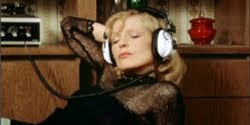 “Fear of Fear” (1975)
“Fear of Fear” (1975)
Starring Fassbinder troupe-regular Margit Carstensen, also the star of “The Bitter Tears of Petra Von Kant” and “Martha,” this made-for-TV psychological drama centers on a working-class housewife who begins to come down with the symptoms of some mental illness resembling schizophrenia. As her disorder (and fear) grows — the onset of disease is likely to cause panic in any human — her caring, but ultimately ineffectual husband proves useless and her borderline abusive step-family do little more than point fingers at her “strange” behavior. To make matters worse she’s then followed by another mentally ill man in her neighborhood (the creepy Kurt Raab, who starred in 31 of Fassbinder’s pictures), who appears to have a kind of psychic connection to her: he unnervingly understands that she’s slowly going mad. Helpless, she turns to alcohol, valium and a pervy doctor (Adrian Hoven) willing to fill her prescription, if you get our drift, and the poor woman quickly slides into full-blown addiction — anything to assuage the painful cognizance of descending into insanity. Clearly made for TV, with its episodic narrative and clunky opening, while “Fear of Fear” threatens to become an afterschool special on the dangers of housewives with psychological problems, ultimately the TV-film rallies and becomes quite the striking look at pain, indifference and callousness. [B]
 “Mother Küsters’ Trip to Heaven” (1975)
“Mother Küsters’ Trip to Heaven” (1975)
When a quiet and unassuming father goes postal at his chemical factory — murdering a man and committing suicide when massive layoffs loom — a gentle German family is torn asunder and destroyed by the news. Exacerbating issues is an invasive tabloid media which descends like so many ravenous vultures, exploiting the devastated family for all they’re worth both in context-distorting quotes and manipulative photo opps. Matters worsen with the return of Corrina, the family’s wayward daughter (Ingrid Caven) who shamelessly uses the tragedy to promote her singing career by sleeping with one of the journalists covering the story. One of Fassbinder’s more politically-charged efforts, the other side of the wanton exploitation comes from the Communist party, masquerading as a kind, benevolent force in the lonely matriarch’s life, but just using the family catastrophe of her “oppressed proletariat husband” for their own agenda. The film has two endings; one is bold and tragic (detailing Mother Kuster’s death as she falls in with a group of anarchists in text over a freeze frame of her woeful face), and the other (the U.S. version) chronicles fate and futility (the anarchists give up their sit-in to defend her husband’s smearing in the tabloids, but she meets an older gentleman who hints at a spark of hope). Featuring many Fassbinder regulars including female stalwarts Margit Carstensen, Irm Hermannn (19 Fassbinder films to her credit) and the always wonderful Brigitte Mira (the star of ‘Ali: Fear Eats The Soul’) as the eponymous mother, Fassbinder’s sardonically dark drama acts as a scathing critique of self-serving opportunists of every stripe and of the bloodthirsty media, while asking if a sense of decency or shame exists in today’s society. [B+]
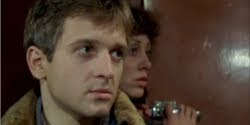 “I Only Want You To Love Me” (1976)
“I Only Want You To Love Me” (1976)
Shot for television and wearing the mark of limited funds and scope, Fassbinder’s docudrama centering on one man’s search for approval is no less effective than some of his strongest work. Peter is a young man desperate to provide for his wife and child, while also living up to the expectations of his parents, but, in a consistent streak of cruel irony, luck keeps leaving his side, as mounting debts and endless favors place him in one hole after another. Through it all, Peter repeats the title mantra, as a way of getting through the day, soon oblivious as to whom he’s actually speaking. The delicate balance of Peter’s everyday life naturally unravels through a spiral of bad decisions that prove fatal, all couched in an interview-framing device that puts a blackly humorous cap on his own existence. Though toned down from his usual work, Fassbinder is working in familiar territory, and the list of indignities allows for several bleak, eye-catching tableaux to be caught on film, in the service of a story about a man who can simply never find approval. [A-]
 “In A Year Of 13 Moons” (1978) – MZ
“In A Year Of 13 Moons” (1978) – MZ
Fassbinder must have loved Armin Meier dearly, because few directors would dare make a film that boils down to personal exorcism. A year with 13 moons spells trouble for protagonist Elvira (Volker Spengler), road tripping to reunite with Anton Saitz (Gottfried John). Anton funded Elvira’s sex change (she was once a butcher named Erwin, an intentional callback to Meier’s profession), but doesn’t want to accept the newly christened woman as anything other than Erwin. “In a Year of 13 Moons” is an endurance test, with several standout sequences, one set in a slaughterhouse and another an out-of-left-field dance sequence. Spengler is also compelling, expressing Elvira’s personal purgatory in which she is accepted by none of the people she desires and finds no peace from her struggles, just strife and hate. Whatever feelings Fassbinder had mixed in with his grief after Meier’s suicide, they are embedded in this film, notable for the director’s continued mastery over camera placement and perhaps an over-reliance on allegory. Like the best Fassbinder films, this one rewards the patient viewer and has gathered quite a loving cult 30 plus years after its inception. [B]
 “The Marriage of Maria Braun” (1979)
“The Marriage of Maria Braun” (1979)
The first in Fassbinder’s BRD (Bundesrepublik Deutschland) Trilogy, which deals with three different women making their way in a post-WWII Germany, the script went through several hands and drafts from Fassbinder’s original unrealized TV project “The Marriage of our Parents”. Fassbinder was already working on the script for the epic “Berlin Alexanderplatz” when shooting began on “The Marriage of Maria Braun” and he continued to shoot during the day and work all night on the script for his next project. Rumour has it to sustain this work schedule Fassbinder consumed large quantities of cocaine, and this was the main reason the film went over budget — Fassbinder’s biggest but still under a million USD. Of course this caused problems with his financiers, producers and crew, causing rifts in many of his long-term creative partnerships including those with cinematographer Michael Ballhaus and producer Michael Fengler. Making “The Marriage of Maria Braun” was probably not the greatest period in Fassbinder’s life, but the film turned out to be one of his most successful and fulfilled his desire to make a German equivalent of a Hollywood movie. Starring Hanna Schygulla as Maria (she won the Silver Bear for Best Actress in 1979), a woman whose relationship with her husband, Hermann is constantly thwarted by circumstance – or rather desire, pride and greed which inevitably leads to violence, cruelty and destruction. Fassbinder paints a picture of an insatiable and unfeeling Germany, its inhabitants (the survivors) are damaged goods, both morally and emotionally warped from their experiences. Like any good Hollywood film it ends with a big explosion – like any good Fassbinder film the meanings and motives behind it are open-ended. [A]
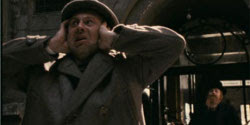
“Berlin Alexanderplatz” (1980)
Yes, we’ve seen it. Yes, all of it. Yes, it’s glacially slow in places, and admittedly hard work. And yes, it’s absolutely worth doing at some point in your life. Fassbinder’s 14-part, 930 minute made-for-TV (but theatrically released in the U.S.) epic has a fearsome reputation, entirely deserved (particularly the impenetrable, fitfully brilliant, occasionally eye-rolling epilogue), mostly because it’s arguably as close to a novel as cinema’s ever gotten. A straight translation of the plot would have been far shorter, but Fassbinder, a rabid fan of the 1929 source material (by Alfred Doblin), digresses and dwells, stretching and repeating tiny, intimate moments, with trademark long, unbroken takes, in a way that slowly brings you into the psyche of protagonist Franz Biberkopf (an astonishing performance by Gunter Lampretcht), and indeed, the psyche of a nation in turmoil (hindsight obviously gives Fassbinder permission to use Biberkopf as a metaphor for interwar Germany, adding up to arguably one of his most political films. And of course, it always feels like a Fassbinder film, particularly in his tinkering with his hero’s relationship with Reinhold (Gottfried John), which gains all kinds of homo-erotic undertones absent from the novel. More than anything, however, it’s a tragedy; an ex-convict, desperate to go straight, just can’t escape. An old story, to be sure, but one that’s never been told with as much detail. There are amazing moments throughout, and awful ones, none more so than in that epilogue, which sees Fassbinder essentially deconstruct (aided by Lou Reed and Kraftwerk tracks) the thirteen hours you’ve just sat through. It’s both infuriating and intoxicating, and a fitting capper to the whole whopping saga. File it with “War and Peace” and “Infinite Jest” as something to catch up on during a long holiday or prison sentence: you’ll certainly not regret it. [B]
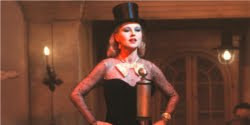 “Lili Marleen” (1981)
“Lili Marleen” (1981)
The insurmountability of social barriers, and the war between private desire and public image are staples of the Sirkian melodrama Fassbinder emulated throughout his latter career. So as a backdrop, Nazi Germany, an oppressively totalitarian state in which private lives were often forfeit to the political machine, and racial, gender and national barriers were not just reinforced, but codified into an ethos that permeated every aspect of life, must represent some sort of melodrama jackpot. Strange, then, that “Lili Marleen,” a WWII-era tale of the forbidden love between a German nightclub singer and a Swiss Jewish conductor, should end up such an unengaging affair: the pieces are all there, and the onscreen emotional register ranges from the peaks of ecstasy to the depths of suicidal despair, as one might expect, and yet, we never feel much of anything at all. Fassbinder regular Hanna Schygulla’s performance as the central Willi is part of the problem, coming off as oddly schizoid – her reactions, while fittingly overwrought, are often inappropriate to the point of incomprehensible. And without the kind of tragic empathy the great heroines of this genre manage to engender, it’s hard to care for the pragmatic, self-absorbed, narcissistic Willi (we’re not even sure she’d be morally opposed to Nazism if it didn’t keep her from her lover) especially when the very thing that makes her famous is her rather underwhelming rendition of the titular song. The film is not bad, exactly, its lush costuming and dewy soft-focus photography hit the mark, and there are moments of sudden, weird surreality (the drunken sequence in the luxurious white house, a uniformed Nazi arriving on stage via a slide) that perk things up immeasurably. But there are also times when these experimental forays don’t pay off (the interminably returned-to scene in which Willi’s lover is tortured with incomplete snatches of the song endlessly repeated, layers unintentional irony on top of intentional as we, the audience, pray for the damn thing to stop too) and ultimately nothing can distract from the emptiness at the film’s heart. It’s where a real woman, or at least melodrama’s exaggerated version of a real woman, and someone we can care about and become involved with, should be. [B-]
 “Lola” (1981)
“Lola” (1981)
Fassbinder’s fetish for exquisitely staged Sirk-ian melodrama, an obsession for at least part of his career, is well-documented, so if one wants to see the picture that likely lathered up Fassbinder the most (and was probably also an influence on Todd Haynes‘ similar Sirk proclivities), it’s the lush, candy-colored and sumptuous-looking “Lola.” Another BRD trilogy film set in post-World War II West Germany, the film stars Barbara Sukowa and the great Armin Mueller-Stahl (“Night on Earth,” “Eastern Promises“), and centers on a pious building commissioner looking to eradicate the corruption taking place within the business of local construction entrepreneur (Mario Adorf). Gradually gathering evidence against his prey, the straight-arrow man then meets and eventually falls in love with the titular Lola (Sukowa). Consequently, he’s shocked to learn that she’s a prostitute and cabaret singer in a local brothel. Not only that, she’s the plaything of Schukert, the crooked construction magnate he’s trying to topple. While he now possesses all the ammo he needs, Mueller-Stahl’s Von Bohm fails to reconcile his righteous duty with his lust for the fetching woman, instead falling prey to seduction and soon, to the temptations of money and power. In Fassbinder’s absorbing morality tale, we watch a honorable man become the very vile thing he attempted to fight against. A darkly, yet subtly satiric nod to the persuasive charms of capitalism, as usual, Fassbinder feels no need to underscore or underline the obvious, we watch this beautifully-shot fall from grace and any judgement is our own. [A]
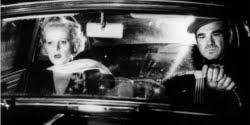 “Veronika Voss” (1982)
“Veronika Voss” (1982)
Loosely based on the true story of Sybille Schmitz, a former Nazi starlet, whose star faded after the Third Reich crumbled — she committed suicide as a lonely old relic the nation would rather soon forget — the captivating and lush “Veronika Voss,” is Fassbinder at the height of his powers and sadly, it is his penultimate film. It is his “Sunset Boulevard” and “Citizen Kane,” literally and figuratively as both films bear resemblances to the stylish, high contrast black-and-white picture that shows obvious traces of the sumptuous Hollywood filmmaking of the 1950s. On a dark, rain-soaked evening, the unbalanced and melodramatic Voss (Rosel Zech) meets and befriends an empathetic sports writer (Hilmar Thate) who takes a curious interest in her faded-glory story. The well-meaning writer soon discovers the erratic and often desperate former star is propped up by an unscrupulous “Dr. Feelgood”-like physician (Annemarie Düringer), who lords over her — fueling her insecurities with a controlling dose of opiates, but only if she can pony up the exorbitant costs. Meanwhile, the self-sacrificing writer risks his own relationship to rescue the aging ingenue, but to no avail. Having long sought recognition within Germany — the provincial media generally despised his always quotable “enfante terrible” mien — Fassbinder finally received homegrown love when this picture rightfully won the Golden Bear at the 32nd Berlin International Film Festival. [A]
And The Rest: Three shorts preceded “Love Is Colder Than Death”; “This Night,” which is lost, “The City Tramp” and “The Little Chaos.” It was then followed by “Katzelmacher,” which translates, roughly, as “Cock Artist” — not, as the title might suggests, about Warren Beatty, but an adaptation of Fassbinder’s play, about a Greek immigrant (played by the filmmaker himself). 1970 brought “Gods of the Plague” and “The Coffee House” (the latter only a TV recording of his production of Carlo Goldoni’s play), while the year was topped off with “The Niklashausen Journey,” co-directed with ‘Herr R.’ collaborator Michael Fengler.
That was swiftly followed by “Rio Das Mortes” and “Pioneers in Ingolstadt,” both made for TV, while “Whity” is one of the better-regarded films that we didn’t get to see. “The Merchant of Four Seasons” followed ‘Holy Whore,’ and is seen as one of the director’s very best, although it slipped between the cracks for us. 1972 had another theater-to-TV translation, “Bremen Freedom,” the 5-part TV series “Eight Hours Are Not A Day,” while 1973 brought “Wild Game” (based on the Kroetz play), and the aforementioned “World on a Wire,” which we covered in detail last week. It was followed by “Nora Helmer,” a version of Ibsen’s “A Doll’s House” for TV.
The black-and-white “Effi Briest” is another great one that we didn’t have time to cover, while 1975 brought the short “Like A Bird on a Wire” (unconnected to the Goldie Hawn vehicle, unsurprisingly…). 1976 gave us “Satan’s Brew” and “Chinese Roulette,” while 1977 had “Women In New York” and “The Stationmaster’s Wife,” both made for TV, while he directed a segment of the omnibus “Germany in Autumn” the following year.
“Despair” was his closest flirtation with the mainstream, adapting a Nabokov novel with a Tom Stoppard script (in English, no less), starring Dirk Bogarde, while 1979 brought “The Third Generation” a terrorism black comedy starring Eddie Constantine, star of “Alphaville.” Finally, he made his sole venture into documentary with 1981’s “Theatre in Trance,” and ended his career with 1982’s “Querelle,” another English-language film, based on Jean Genet’s novel and starring Franco Nero, Jeanne Moreau and “Midnight Express” lead Brad Davis.
— Rodrigo Perez, Christopher Bell, Sam Chater, Gabe Toro, Mark Zhuravsky, Jessica Kiang, Oliver Lyttelton
